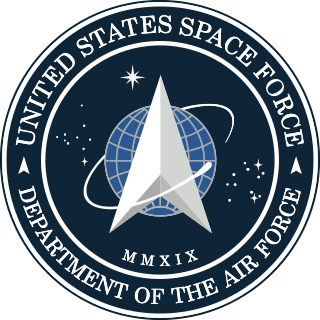 W
WThe United States Space Force (USSF) is the space service branch of the U.S. Armed Forces, and is one of the eight U.S. uniformed services. Initially formed as Air Force Space Command on 1 September 1982, the Space Force was established as an independent military branch on 20 December 2019, with the signing of the United States Space Force Act, part of the National Defense Authorization Act for 2020.
 W
WAir Force Space Command (AFSPC) was a major command of the United States Air Force from September 1982 to December 2019. On 20 December 2019, concurrent with the signing of the National Defense Authorization Act for 2020, it was re-designated as the United States Space Force and became a new sixth service branch of the United States Armed Forces responsible for space warfare.
 W
WThe chief of space operations (CSO) is a statutory office held by a general in the United States Space Force, and is the principal military adviser to the secretary of the Air Force for Space Force operations; and is in a separate capacity a member of the Joint Chiefs of Staff, and thereby a military adviser to the National Security Council, the secretary of defense, and the president. The chief of space operations is typically the highest-ranking officer on active duty in the Space Force unless the chairman or the vice chairman of the Joint Chiefs of Staff are Space Force officers.
 W
WThe flag of the United States Space Force is the flag used to represent the United States Space Force, as well as its subsidiary units and formations. It was officially unveiled on 15 May 2020.
 W
WEWS-G1 is a weather satellite of the U.S. Space Force, formerly GOES-13 and part of the National Oceanic and Atmospheric Administration's Geostationary Operational Environmental Satellite system. On 14 April 2010, GOES-13 became the operational weather satellite for GOES-East. It was replaced by GOES-16 on 18 December 2017 and on 8 January 2018 its instruments were shut off and it began its three-week drift to an on-orbit storage location at 60.0° West longitude, arriving on 31 January 2018. It remained there as a backup satellite in case one of the operational GOES satellites had a problem until early July 2019, when it started to drift westward and was being transferred to the U.S. Air Force, and then the U.S. Space Force.
 W
WThe Seal of the United States Space Force is the official seal of the U.S. Space Force, the space warfare service branch of the U.S. Armed Forces. The seal itself was approved on 15 January 2020.
 W
WThe Space Force Delta is the official logo of the U.S. Space Force, the space warfare service branch of the U.S. Armed Forces. The delta itself was unveiled on 22 July 2020.
 W
WThe Space Test and Training Range (STTR) is a space electronic warfare range controlled by the United States Space Force and is located at Schriever Air Force Base, Colorado. The 25th Space Range Squadron and their reserve associate unit, the 379th Space Range Squadron operate and maintain the STTR.
 W
WThe vice chief of space operations (VCSO) is an office held by a four-star general in the United States Space Force. The vice chief directly supports the chief of space operations (CSO) by serving as a member of the Joint Requirements Oversight Council (JROC) and also operates with the full authority of the chief of space operations during the CSO’s absence. The vice chief of space operations is be nominated for appointment by the president and confirmed by the Senate. The vice chief of space operations is be the second-highest position in the U.S. Space Force, equivalent to other services' vice chief positions. The current vice chief of space operations is General David D. Thompson.